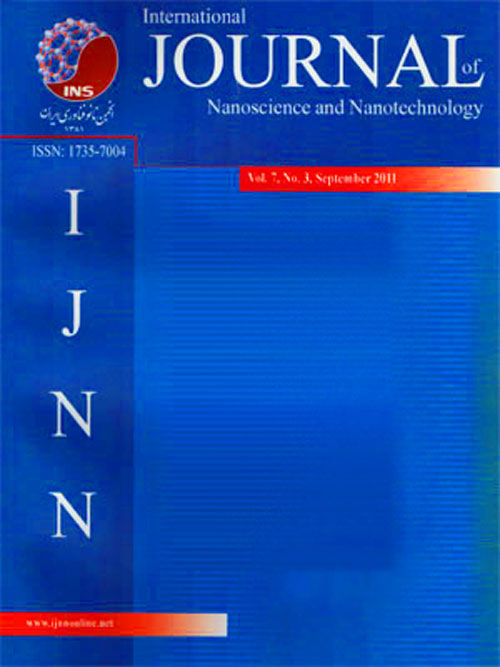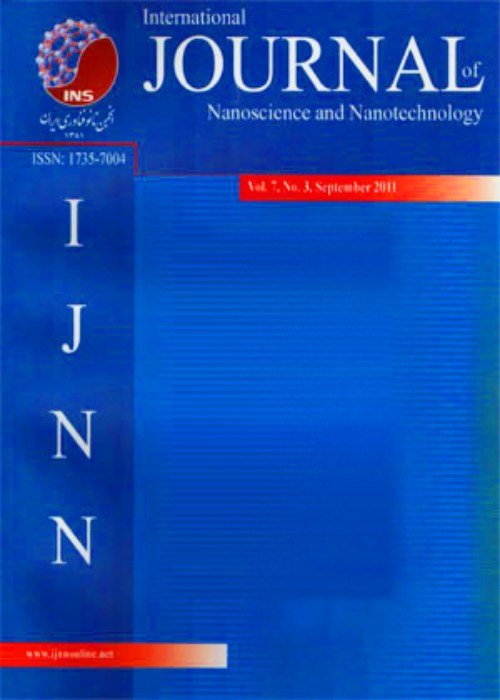فهرست مطالب

International Journal Of Nanoscience and Nanotechnology
Volume:12 Issue: 4, Autumn 2016
- تاریخ انتشار: 1395/09/29
- تعداد عناوین: 8
-
-
Pages 199-206Bio-directed synthesis of nanoparticles is an interesting field of rapid advancement for biologists, chemists and materials scientists, especially in light of efforts to find out green methods of inorganic material synthesis. In the present study, green synthesis of platinum nanoparticles (PtNPs) using sheep milk is reported for the first time. By adjusting the concentrations of chloroplatinic acid ( 2PtCl6) and milk in aqueous solutions, spherical PtNPs were obtained at room temperature. The nanoparticles obtained were characterized by UV-Vis spectroscopy, dynamic light scattering (DLS), high resolution Transmission Electron Microscopy (TEM) and X-Ray diffraction (XRD). The spherical particles obtained have an average size 9.0 nm as shown by XRD pattern and TEM analysis. Fourier Transform Infra-Red (FTIR) measurements were carried out to identify the possible biomolecules responsible for capping and efficient stabilization of the PtNPs synthesized by milk. The carboxylic acid group libration and amide I and II bands revealed the binding of protein with platinum surface through the amine group rather than the carboxyl group. Among a wide variety of biological resources which are introduced for reducing Pt ions into PtNPs, green approaches like using sheep milk have outstanding benefits for synthesize biological metal nanoparticles due to their eco-friendly phenomenon and very less amounts of cytotoxicity. PtNPs green synthesized in this study are potential candidates to use in drug discovery and gene transfer technologies.Keywords: Green synthesis, Platinum nanoparticles, Sheep milk, Electron microscopy, Physicochemical characterization
-
Pages 207-214Among the various phases of alumina, two phases γ and α are the most widely used in various industries. In this paper, γ-Al2O3 porous nanoparticles have been successfully synthesized from a simple aqueous solgel method using inexpensive material such as: sodium aluminate liquor, HCl, NaOH, Polyethylene glycol (PEG) and polyvinyl alcohol (PVA). Sodium aluminate liquor was extracted from Bayer liquor of alumina product processed in the Jajarm alumina factory. PEG and PVA were used as structure-stabilizing agents. The structures and properties of samples calcined at 800 ºC, were performed utilizing X-ray diffraction (XRD), infrared spectroscopy (FTIR), scanning electronmicroscopy (SEM), termogeravimetery analysis (TG/DTA), and N2 adsorption/desorptiontechniques. Prepared sample of γ-Al2O3 with polyethylene glycol surfactant has an average crystallite size of 2.313 nm, average particle size of 20 nm, specific surface area (SSA) of 138.8 m2/g, and pore volume of ∼ 0.166 cm3/g. The average crystallite size of 2.063 nm, average particle size of 46 nm, specific surface area of 201.1 m2/g, and pore volume of ∼ 0.246 cm3/g, were achieved using polyvinyl alcohol surfactant.Keywords: ?, alumina, Porous, Sodium aluminate liquor, Nanoparticles, Surfactant
-
Pages 215-222In this work, an efficient and facile method has been developed for the synthesis of 2,3- dihydroquinazolin-4(1H)-ones from a condensation reaction of 2-aminobenzamide with various alkyl, aryl and alicyclic aldehydes or ketones using Fe3O4/chitosan as an environmentally benign, magnetically recoverable nanocomposite catalyst in ethanol at room temperature in high to excellent yields under mild reaction conditions. The Fe3O4/chitosan composite nanocatalyst was first prepared by a sol-gel method and characterized by using a variety of conventional techniques including Fourier transforms infrared spectroscopy (FT-IR), scanning electron microscopy (SEM), energy-dispersive X-ray (EDX) andX-ray diffraction (XRD) analyses. The present work include several advantages such as avoiding the use of toxic solvents or expensive catalysts, generality, high yields, short reaction times, clean reaction profile, ease of product isolation, simplicity, recyclability of the catalyst and finally agreement with the green chemistry protocols. All make it a useful and attractive protocol for the synthesis of heterocyclic compounds like quinazolinone derivatives.Keywords: Magnetic nanoparticles, Fe3O4, Chitosan, Dihydroquinazolinone, Heterogeneous catalysts
-
Pages 223-232Nitrate-containing compounds are considered as groundwater contaminants, the concentration of which has been growing in these resources during recent years. As a result, it seems necessary to use effective methods to remove nitrate from water and wastewater. Adsorption is generally considered more economical in water treatment compared to other feasible alternative techniques. Natural Clinoptilolite zeolite is one of the best absorbents because of its high capacity and low cost. Surfactants such as hexadecyl trimethyl ammonium (HDTMA) are usually used for modification but they are not stable and removed as a result of subtle temperature variations. In this research, zeolite nanoparticles are chemically modified by 3-aminopropyl triethoxysilane. The advantage of this modification method is its stability at different environmental conditions. Adsorbent properties have been analyzed by PSA, FTIR, XRD, FESEM and CHN elemental analysis. Also, nitrate adsorption capacity of modified zeolite was examined by UV-Vis spectroscopy. NH2 groups are developed on the zeolite surface as a result of organo-silane modification, which must be converted to NH4 so that nitrate adsorption becomes possible in acidic conditions. Based on the results, the best nitrate removal capacity is achieved at the lowest concentration and pH values. 80.12 % nitrate removal was obtained at pH=3, nitrate concentration = 50 mg/l and adsorbent concentration = 4 g/l.Keywords: Nitrate removal, Zeolite, Surface modification, Organo, silane, Adsorption
-
Pages 233-241In this study, a new graphene ceramic composite (GCC) was prepared based on the reduced graphene oxide (rGO) doped in sol-gel derived silica. The GCC was prepared by dispersing rGO nanosheets into the sol-gel precursors containing methyl triethoxysilane, methanol and hydrochloric acid solution. During an acid catalyzed hydrolyze reaction and gelation process, rGO nanosheets were successfully doped into the prepared gel. The fabricated GCC was characterized by field emission scanning electron microscopy, Transmission electron microscopy, Fourier transform infrared spectroscopy, X ray diffraction, thermogravimetric analysis, cyclic voltammetry and galvanostatic charge/discharge techniques. According to the electrochemical results, the prepared GCC has shown remarkable specific capacitance in comparison with carbon ceramic composite. Due to unique configuration of GCC and large specific surface area of rGO, the resultant GCC shows specific capacitance of 428 F g-1 at current density of 1 A g-1and good cycling stability using three electrode system.Keywords: Graphene, Sol, gel, Double layer capacitor
-
Pages 243-249In mathematical chemistry, a particular attention is given to degree-based graph invariant. The Zagreb polynomial is one of the degree based polynomials considered in chemical graph theory. A dendrimer is an artificially manufactured or synthesized molecule built up from branched units called monomers. In this note, the first, second and third Zagreb polynomials of some nanostar dendrimers are determined.Keywords: Zagreb polynomial, Dendrimer, Graph
-
Pages 251-268The steady two-dimensional flow of a viscous nanofluid of magnetohydrodynamic (MHD) flow and heat transfer characteristics for the boundary layer flow over a nonlinear stretching sheet is considered. The flow is caused by a nonlinear stretching sheet with effects of velocity, temperature and concentration slips. Problem formulation is developed in the presence of heat generation/absorption and suction/injection parameters on non-linear stretching sheet. The resulting governing equations are converted into a system of nonlinear ordinary differential equations by applying a suitable similarity transformation and then solved numerically using Keller-Box technique. Convergences of the derived solutions are studied. The effects of the different parameters on the velocity, temperature, and concentration profiles are shown and discussed. Numerical values of local skin-friction coefficient, local Nusselt number and Sherwood number are tabulated. It is found that the velocity profiles decreases, temperature and concentration profiles increases with increasing of velocity slip parameter, and the thermal boundary layer thickness increases with increasing of Brownian motion and thermophoresis parameters.Keywords: Nanofluid, MHD, Slip effects, Heat generation, absorption, Suction, Injection
-
Pages 269-275New extension of nanoparticles used in the last two decades and hence, entrance of them to industrial and non-industrial sewage necessitate study of probable effects of these materials in aquatic ecosystems. This research was performed in order to determine the toxicity effect of silica dioxide (Si 2) nano particles on Dunaliella salina green algae in laboratory conditions. SiO2 nanoparticle is one of the best full-used nano particles which have application in industries like production of ceramics, plastics, glass, cosmetics, medicine and paper. Dunaliella algae because of having economic value and different biochemical composition is used as complements with natural origin in food and pharmacology industries. For toxicity determination of this material, the experiment was performed according to O.E.C.D standard method. Experiments on Dunaliella were performed for 72 hours with 7 treatments, two controls and three replicates in each treatment and daily counting of cells in each tube. Counting cell algae population was done by microscope on a Thoma counting slide. For data analysis, probit analysis, Excel software and SPSS21 were used. The 72 hours NOEC, EC90, EC50 and E 10 were calculated. The amounts of 72 hours are EC10 =5.37.10-5 , EC50 = 0.169 , EC90 = 512.86, NOEC = 1.6×10-2 mg/l. Cell compression noticeably decreased (PKeywords: Algae Dunaliella salina, EC50, SiO2, Toxicity, Nanoparticles, Nanotechnology


